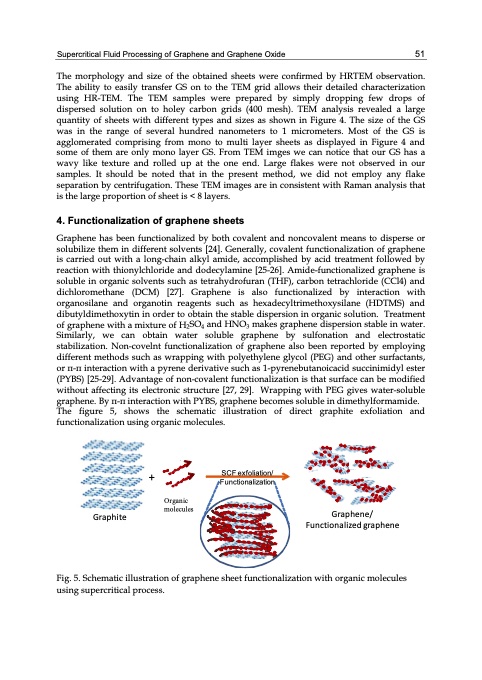
PDF Publication Title:
Text from PDF Page: 061
Supercritical Fluid Processing of Graphene and Graphene Oxide 51 The morphology and size of the obtained sheets were confirmed by HRTEM observation. The ability to easily transfer GS on to the TEM grid allows their detailed characterization using HR-TEM. The TEM samples were prepared by simply dropping few drops of dispersed solution on to holey carbon grids (400 mesh). TEM analysis revealed a large quantity of sheets with different types and sizes as shown in Figure 4. The size of the GS was in the range of several hundred nanometers to 1 micrometers. Most of the GS is agglomerated comprising from mono to multi layer sheets as displayed in Figure 4 and some of them are only mono layer GS. From TEM imges we can notice that our GS has a wavy like texture and rolled up at the one end. Large flakes were not observed in our samples. It should be noted that in the present method, we did not employ any flake separation by centrifugation. These TEM images are in consistent with Raman analysis that is the large proportion of sheet is < 8 layers. 4. Functionalization of graphene sheets Graphene has been functionalized by both covalent and noncovalent means to disperse or solubilize them in different solvents [24]. Generally, covalent functionalization of graphene is carried out with a long-chain alkyl amide, accomplished by acid treatment followed by reaction with thionylchloride and dodecylamine [25-26]. Amide-functionalized graphene is soluble in organic solvents such as tetrahydrofuran (THF), carbon tetrachloride (CCl4) and dichloromethane (DCM) [27]. Graphene is also functionalized by interaction with organosilane and organotin reagents such as hexadecyltrimethoxysilane (HDTMS) and dibutyldimethoxytin in order to obtain the stable dispersion in organic solution. Treatment of graphene with a mixture of H2SO4 and HNO3 makes graphene dispersion stable in water. Similarly, we can obtain water soluble graphene by sulfonation and electrostatic stabilization. Non-covelnt functionalization of graphene also been reported by employing different methods such as wrapping with polyethylene glycol (PEG) and other surfactants, or π-π interaction with a pyrene derivative such as 1-pyrenebutanoicacid succinimidyl ester (PYBS) [25-29]. Advantage of non-covalent functionalization is that surface can be modified without affecting its electronic structure [27, 29]. Wrapping with PEG gives water-soluble graphene. By π-π interaction with PYBS, graphene becomes soluble in dimethylformamide. The figure 5, shows the schematic illustration of direct graphite exfoliation and functionalization using organic molecules. + Organic molecules SCF exfoliation/ Functionalization Graphite Graphene/ Functionalized graphene Fig. 5. Schematic illustration of graphene sheet functionalization with organic molecules using supercritical process.PDF Image | GRAPHENE SYNTHESIS CHARACTERIZATION PROPERTIES

PDF Search Title:
GRAPHENE SYNTHESIS CHARACTERIZATION PROPERTIESOriginal File Name Searched:
Graphene-Synthesis.pdfDIY PDF Search: Google It | Yahoo | Bing
Salgenx Redox Flow Battery Technology: Power up your energy storage game with Salgenx Salt Water Battery. With its advanced technology, the flow battery provides reliable, scalable, and sustainable energy storage for utility-scale projects. Upgrade to a Salgenx flow battery today and take control of your energy future.
| CONTACT TEL: 608-238-6001 Email: greg@infinityturbine.com | RSS | AMP |